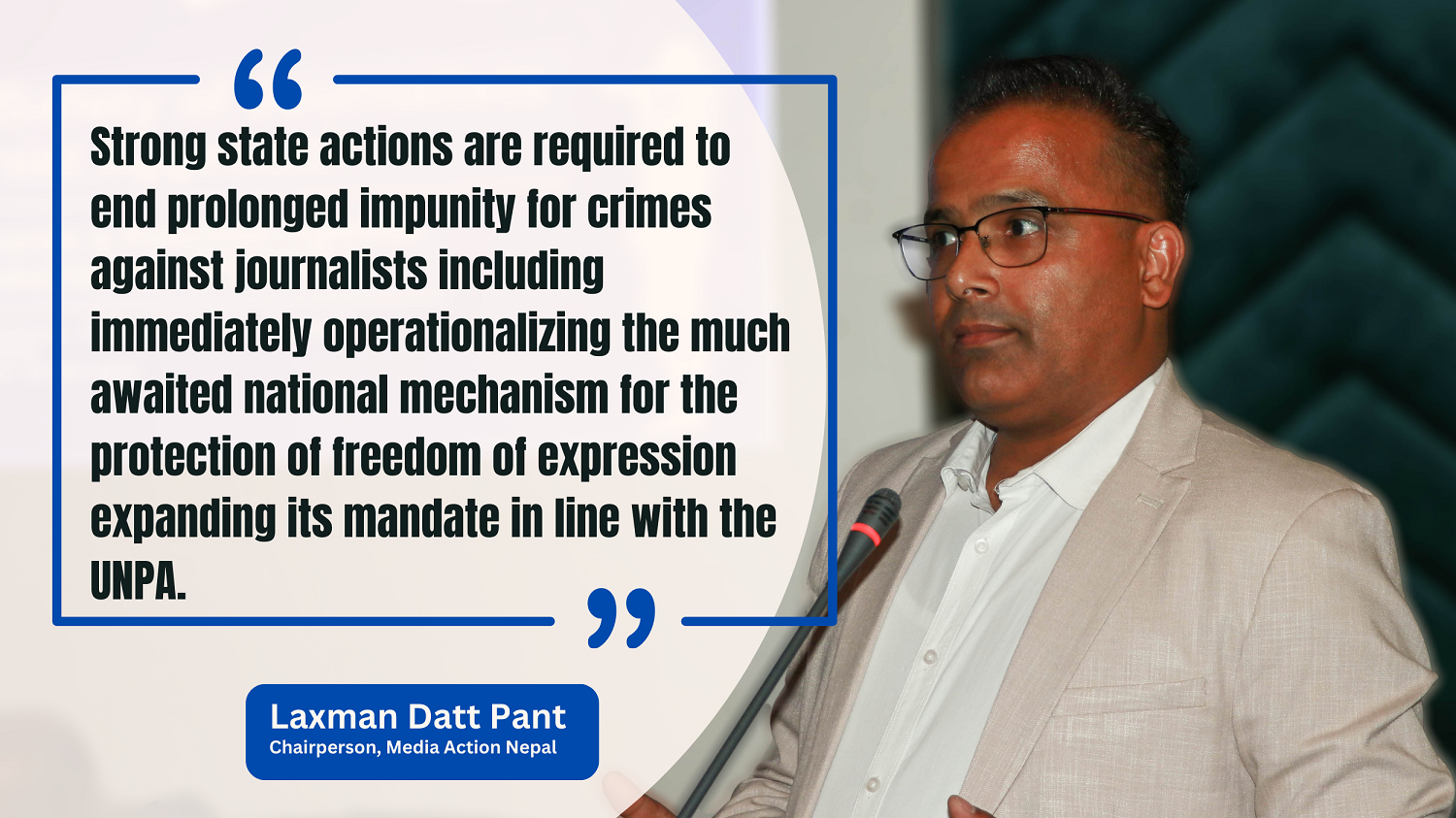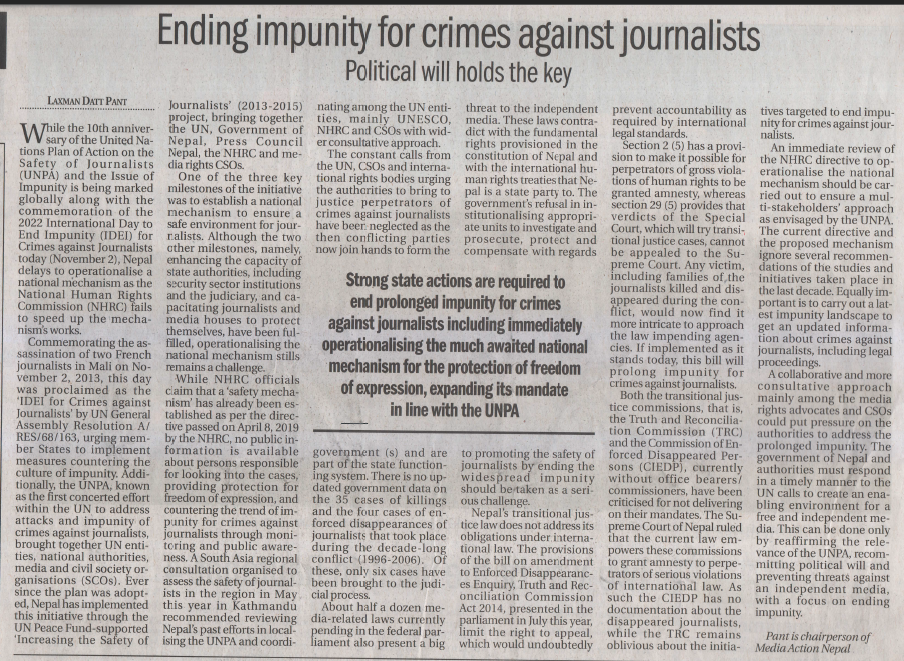
Ending impunity for crimes against journalists in Nepal
KATHMANDU/August 18: While the 10th anniversary of the United Nations Plan of Action on the Safety of Journalists (UNPA) and the Issue of Impunity is being marked globally along with the commemoration of the 2022 International Day to End Impunity (IDEI) for Crimes against Journalists today (November 2), Nepal delays to operationalise a national mechanism as the National Human Rights Commission (NHRC) fails to speed up the mechanism’s works.
Commemorating the assassination of two French journalists in Mali on November 2, 2013, this day was proclaimed as the ‘IDEI for Crimes against Journalists’ by UN General Assembly Resolution A/ RES/68/163, urging member States to implement measures countering the culture of impunity. Additionally, the UNPA, known as the first concerted effort within the UN to address attacks and impunity of crimes against journalists, brought together UN entities, national authorities, media and civil society organisations (SCOs). Ever since the plan was adopted, Nepal has implemented this initiative through the UN Peace Fund-supported ‘Increasing the Safety of Journalists’ (2013-2015) project, bringing together the UN, Government of Nepal, Press Council Nepal, the NHRC and media rights CSOs.
Strong state actions are required to end prolonged impunity for crimes against journalists including immediately operationalizing the much awaited national mechanism for the protection of freedom of expression expanding its mandate in line with the UNPA.
One of the three key milestones of the initiative was to establish a national mechanism to ensure a safe environment for journalists. Although the two other milestones, namely, enhancing the capacity of state authorities, including security sector institutions and the judiciary, and capacitating journalists and media houses to protect themselves, have been fulfilled, operationalising the national mechanism stills remains a challenge.
While NHRC officials claim that a ‘safety mechanism’ has already been established as per the directive passed on April 8, 2019 by the NHRC, no public in- formation is available about persons responsible for looking into the cases, providing protection for freedom of expression, and countering the trend of impunity for crimes against journalists through monitoring and public awareness. A South Asia regional consultation organised to assess the safety of journalists in the region in May, this year in Kathmandu recommended reviewing Nepal’s past efforts in localising the UNPA and coordinating among the UN entities, mainly UNESCO, NHRC and CSOs with wider consultative approach.
The constant calls from the UN, CSOs and international rights bodies urging the authorities to bring to justice perpetrators of crimes against journalists have been neglected as the then conflicting parties now join hands to form the government (s) and are part of the state functioning system. There is no up- dated government data on the 35 cases of killings and the four cases of en- forced disappearances of journalists that took place during the decade-long conflict (1996-2006). Of these, only six cases have been brought to the judicial process.
About half a dozen media-related laws currently pending in the federal parliament also present a big threat to the independent media. These laws contradict with the fundamental rights provisioned in the constitution of Nepal and with the international human rights treaties that Nepal is a state party to. The government’s refusal in institutionalising appropriate units to investigate and prosecute, protect and compensate with regards to promoting the safety of journalists by ending the widespread impunity should be taken as a serious challenge.
The government’s refusal in institutionalising appropriate units to investigate and prosecute, protect and compensate with regards to promoting the safety of journalists by ending the widespread impunity should be taken as a serious challenge.
Nepal’s transitional justice law does not address its obligations under international law. The provisions of the bill on amendment to Enforced Disappearances Enquiry, Truth and Reconciliation Commission Act 2014, presented in the parliament in July this year, limit the right to appeal, which would undoubtedly prevent accountability as required by international legal standards.
Section 2 (5) has a provision to make it possible for perpetrators of gross violations of human rights to be granted amnesty, whereas section 29 (5) provides that verdicts of the Special Court, which will try transitional justice cases, cannot be appealed to the Supreme Court. Any victim, including families of the journalists killed and dis- appeared during the conflict, would now find it more intricate to approach the law impending agencies. If implemented as it stands today, this bill will prolong impunity for crimes against journalists.
Both the transitional justice commissions, that is, the Truth and Reconciliation Commission (TRC) and the Commission of En- forced Disappeared Persons (CIEDP), currently without office bearers/ commissioners, have been criticised for not delivering on their mandates. The Supreme Court of Nepal ruled that the current law empowers these commissions to grant amnesty to perpetrators of serious violations of international law. As such the CIEDP has no documentation about the disappeared journalists, while the TRC remains oblivious about the initiatives targeted to end impunity for crimes against journalists.
An immediate review of the NHRC directive to operationalise the national mechanism should be carried out to ensure a multi-stakeholders’ approach as envisaged by the UNPA. The current directive and the proposed mechanism ignore several recommendations of the studies and initiatives taken place in the last decade. Equally important is to carry out a latest impunity landscape to get an updated information about crimes against journalists, including legal proceedings.
An immediate review of the NHRC directive to operationalise the national mechanism should be carried out to ensure a multi-stakeholders’ approach as envisaged by the UNPA. The current directive and the proposed mechanism ignore several recommendations of the studies and initiatives taken place in the last decade. Equally important is to carry out a latest impunity landscape to get an updated information about crimes against journalists, including legal proceedings.
A collaborative and more consultative approach mainly among the media rights advocates and CSOS could put pressure on the authorities to address the prolonged impunity. The government of Nepal and authorities must respond in a timely manner to the UN calls to create an enabling environment for a free and independent me- dia. This can be done only by reaffirming the relevance of the UNPA, recommitting political will and preventing threats against an independent media, with a focus on ending impunity.

(This article written by Laxman Datt Pant, Chairperson of Media Action Nepal, was originally published in The Himalayan Times English Daily on November 2, 2022.)